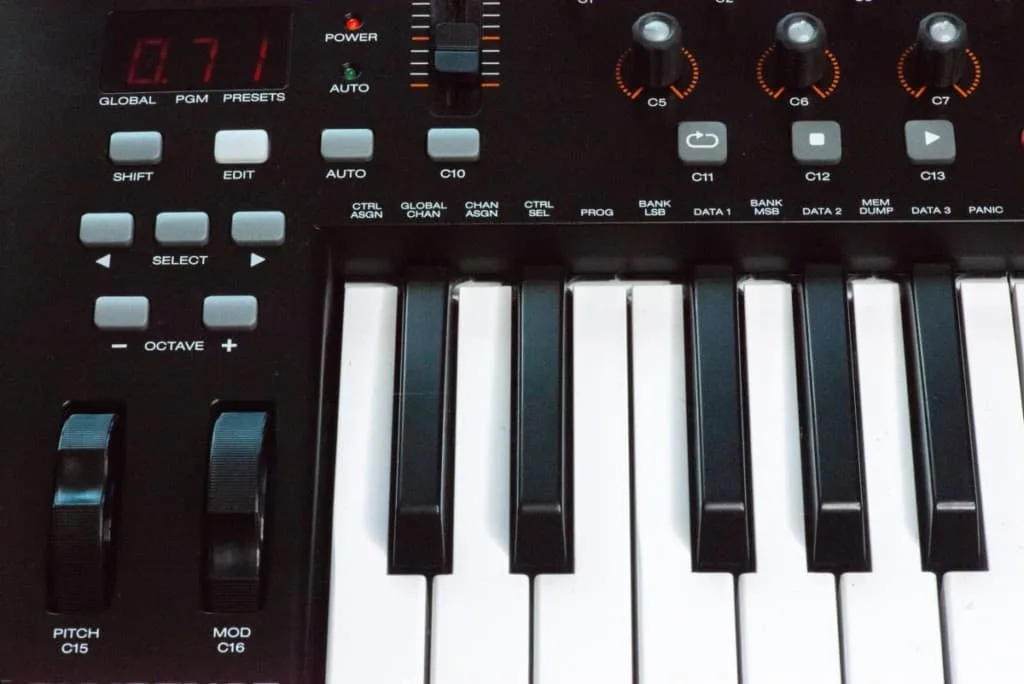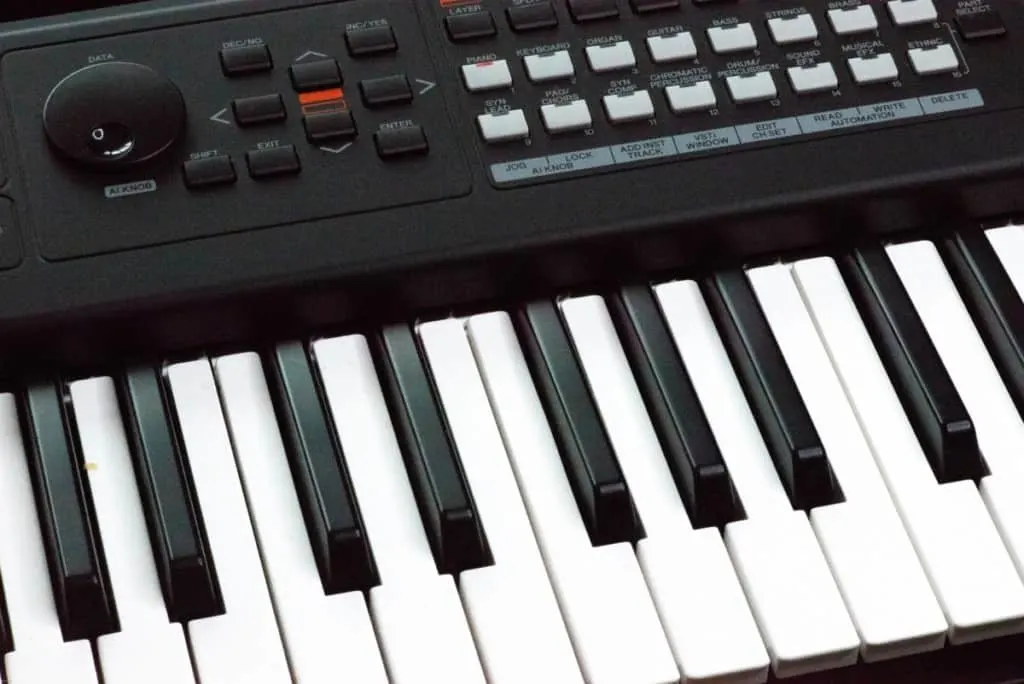It’s common for music producers to utilize their laptop’s keyboard for inputting MIDI into their DAW. Using an external USB keyboard for this purpose seems more practical, but whether it is possible requires further inspection.
Using the inbuilt keyboard on a laptop is sometimes impractical. Using an external USB keyboard seems like a logical solution, but whether or not this is possible is a topic that requires further inspection.
Can a USB keyboard be used with a laptop?
This is certainly possible in most cases. Providing that the laptop in question supports USB connectivity and the keyboard itself is compatible with the particular make and model, there is no reason that the two can’t be successfully used together.
Despite the general compatibility of USB keyboards with laptops, there are other factors that may affect this. For example, keyboards that are significantly older than the laptop in question may require you to download certain drivers for a successful connection. This article will present all of the relevant information you need to know on the topic.

Using A USB Keyboard With a Laptop
In this day and age, it would be difficult to find a laptop that doesn’t have multiple onboard USB ports. Considered to be a universal connection, USB is featured on any laptop regardless of the make, model, or country of manufacturing.
Therefore, USB keyboards should in theory be compatible with all laptops, with some very rare exceptions. Regardless of whether the laptop in question was produced by Microsoft or Apple, it is highly likely that you can use a USB keyboard with it.
One of the only situations, where a USB keyboard may not be compatible with a laptop, is if the keyboard has a different sized USB connector than the standard variation. There are four main types of USB connectors, which come in different shapes and sizes.
To know definitively whether or not a USB keyboard can be used with a particular laptop, we need to establish the differences between the main varieties of these connectors.
The table below displays these differences:
| USB Type | Connector Size | Main Use |
| Standard USB | 4.5mm x 12mm | Keyboard, Mouse, Charger |
| Mini-USB | 3 x 7mm | Digital device chargers |
| Micro-USB | 6.85 x 1.8mm | Digital device chargers |
| USB Type-C | 8.4 x 2.6mm | Laptop chargers |
Since the first version of USB was introduced in 1996, it quickly became the industry standard and remains so to this day. USB keyboards have become hugely popular, overtaking any other form of connection that was previously used to hook up keyboards to laptops and computers.
Why Use A USB Keyboard With a Laptop?
Full-sized USB keyboards are generally easier to use than the onboard keyboard of a laptop. If you frequently use your laptop’s keyboard, you might find that it gets a little crowded, especially when you are typing for long periods of time,
Thankfully, external USB keyboards are easy to connect to a laptop, and they are usually inexpensive. Not only do they provide you with more space to type, but they can also combat the issue of being too close to the laptop’s screen, which can potentially strain your eyes.
Another reason to connect a USB keyboard to your laptop is that you can raise the screen up and avoid having bad posture by having to look downwards at the built-in keyboard as you type. For people who use their laptops a lot for work purposes, researching, or writing documents, it’s very important to sit with the correct posture to avoid repetitive strains in the future.
It’s also worth noting that connecting a USB keyboard won’t usually disable the inbuilt keyboard of your laptop. So in theory, you still have the option to use both. Some laptop keyboards have special control that allows you to quickly connect to WiFi, adjust volume settings, and change the brightness of your screen. These keys will still be available when you use an external USB keyboard, so you get the best of both worlds.
How USB Keyboard Connections Work
To determine whether a USB keyboard can be used with a laptop, we need to closely examine this form of connection and understand exactly how it works.
USB is short for Universal Serial Bus. It is an interface that boasts plug-in-and-play performance and allows for communication between a laptop, computer, or other electronic device and an external device. Arguably the most universally used form of a connector; USB is featured on a wide variety of devices. These include:
- Keyboards
- Mice
- MP3 players
- Mobile phones
- Tablets
- Audio Interfaces
- Microphones
- Cameras
- Gaming consoles
- Flash drives
The USB port on a laptop is usually located either on the side or the back of the device. Depending on the specifics of the laptop, it can house between one and four USB ports, each of which can be used with an external keyboard.
As I touched upon in the previous section, USB connectors come in a variety of forms. It’s most likely that a USB keyboard will use the standard sized connector, but in some rare cases, Mini-USB, Micro-USB, or USB Type-C may be used.
Mini-USB is sometimes referred to as mini-B and is commonly used for digital cameras. In recent years, its popularity has decreased and it has been replaced by Micro-USB and USB-C on state-of-the-art devices.
That brings us to Micro-USB. Created back in 2007, it was presented as a more convenient connector than mini-USB. Micro-USB comes in two different forms: Micro-A and Micro-B. These connectors are most commonly used for gaming controllers, smartphone chargers, and in some cases, computer and laptop accessories.
Finally, USB type-C cables are also popularly used. It’s unlikely that these connectors will be used with a USB keyboard. They are preferred for modern-day Android smartphones and tablets. The great thing about USB-C cables is that unlike the other varieties, it doesn’t matter which way up the connector is when you plug it in.

How Transfer Speeds Affect A USB Keyboard
In addition to the type of USB connector that a keyboard uses, another factor that will significantly affect its ability to run smoothly when used with a laptop is the transfer speed of the inbuilt port.
It’s a common misconception that USB ports on laptops all offer the same level of performance. However, this is not the case. USB ports differ greatly in their ability to transfer data and the speed at which they are capable of doing so.
Let’s take a look at the four most-common USB transfer speeds, and how they would affect a USB keyboard’s ability to perform when hooked up to a laptop.
USB 1.X is capable of supporting anywhere up to 127 external devices. It is the industry standard for external buses and caters to the transference of data at a rate of 12 megabytes per second, which is more than enough for a USB keyboard to function flawlessly.
USB 2.0 is a high-speed alternative. It was first introduced almost two decades ago and impressively can support data transfer at a rapid rate of up to 60 megabytes per second. This type of USB port is very commonly found on older laptops and is fast enough for the majority of external devices to run smoothly.
USB 3.0 was designed to improve upon the commendable performance of USB 2.0. First introduced in 2009, 3.0 ramped up the speed of data transfer and set the standard for years to come. Not only was the speed increased, but its ability to manage power and bandwidth was also noticeably boosted. USB 3.0 is capable of transfer rates up to 640 megabytes per second! It is used on many state of the art laptops.
Finally, the last improvement to USB transfer speed was made in 2013, when the USB 3.1 was revealed. Also known as SuperSpeed+, these ports are capable of transfer rates anywhere up to 10 gigabytes per second. It is used on many Apple laptops and is great for connecting powerful external devices like audio interfaces.
| USB Type | Transfer Speed |
| USB 1.x | 12 Mbps |
| USB 2.0 | 60 Mbps |
| USB 3.0 | 640 Mbps |
| USB 3.1 | 10 Gbps |
USB Keyboards Cable Lengths
One of the main reasons a USB keyboard is useful when used with a laptop is the convenience it provides in terms of positioning. It’s much more comfortable to sit a good distance away from the laptop screen, and using an external USB keyboard is likely to increase the amount of room you have on your desk.
Hand positions can also be tricky when using the onboard laptop keyboard. Repetitive strain injuries are common amongst people who type for long periods, but this can be avoided if there’s adequate space to keep your hands in a comfortable position.
With that being said, it’s important to consider the length of the USB cable that is built into the keyboard. USB cables come in a variety of lengths, some very short to avoid cluttering the workspace, and some very long to allow for long cable runs.
Generally speaking, USB keyboards will have cables that span from roughly 3ft to over 15ft in length. The absolute maximum length of a USB keyboard’s cable is 3 meters (16ft 5”). However, the length of the cable is also likely to correlate with the speed of the device in question.
If you find that your USB keyboard doesn’t have adequate cable length to suit your needs when using it with a laptop, there are some measures you can take to improve this.
USB extension cables provide a practical solution to short cables. They simply connect to one end of the USB cable, and won’t adversely affect its performance unless you exceed the limit of 3 meters, which shouldn’t be the case when using USB keyboards anyway.
USB Keyboards: Wired vs. Wireless
One of the main choices to consider when using a USB keyboard with a laptop is whether a wired or wireless option would be best suited. Laptops are compatible with both, so it comes down to which is more convenient for your specific needs.
Wireless USB keyboards are great if you require the freedom to move around while typing on your laptop. The majority of wireless keyboards can function at a distance of up to 9 meters (30ft).
These keyboards connect to a USB transmitter that is plugged into the laptop’s USB port. If you exceed the range of the keyboard and transmitter, lag is likely to occur, but at close distances, they perform very well and provide you with ample mobility.
Another added bonus of wireless USB keyboards is that they are easier to pack away and transport to another location. For those who work remotely, which is an increasing number of people in this day and age, wired USB keyboards are generally more difficult to pack up and take with you to your place of work.
With wireless USB keyboards, there is no coiling required and the risk of them getting tangled is minimized. This also improves the longevity of the USB keyboard, because the connections are less exposed to wear and tear that inevitably occurs when wrapping up wires and packing the keyboard away.
Another convenient thing about using wireless USB keyboards with your laptop is that you can leave the USB receiver plugged into the port. This allows you to instantly resume use of the keyboard without having to spend time plugging it back in, as you would with a wired USB device.

The Different Types Of USB Keyboards That Can Be Used With A Laptop
We’ve established that USB keyboards can certainly be used with a laptop. Now, it’s useful to look at the various types of USB keyboards that can be used, and their benefits and drawbacks.
USB laptop keyboards generally fall into two categories: extended, and basic. Which type of keyboard best suits your needs depends on a number of factors, such as the amount of time you are likely to spend typing, the keys, and shortcuts that you require to type as efficiently as possible, and what you require to be most comfortable when using your USB keyboard and laptop together.
QWERTY USB Keyboards
The most common variety of USB keyboard is by far the QWERTY layout. Designed to resemble the layout of vintage typewriters, these keyboards are used to teach the majority of people when they first use a laptop or computer.
USB keyboards that use the QWERTY layout are convenient, familiar, and easy to use. The only time when it might be beneficial to switch to a different layout of the keyboard is if you feel that your word-per-minute rate would improve by doing so. In this case, the old saying “if it isn’t broke, don’t fix it” is appropriate.
Numeric USB Keyboards
If you use your laptop for numerical purposes a lot, having an external USB keyboard that is exclusively for this purpose may be a useful addition. Numeric keyboards only feature the numbers and are often laid out in a similar way to a calculator. Some people find the positioning of numbers on a standard QWERTY keyboard to be inconvenient, especially if they are inputting lots of data into their laptops.
Numeric USB keyboards are great for quickly adding numbers to spreadsheets, or adding up multiple figures. You can position this type of keyboard alongside your QWERTY USB device so that you are able to quickly switch between the two when required.
Ergonomic USB Keyboards
If you’re likely to be using your USB keyboard and laptop to type for long periods of time, it might be worth considering an ergonomic option. Designed to minimize the strain that your hands are subjected to, these USB keyboards encourage you to develop the right posture, technique, and positioning to avoid injury.
They still use the standard QWERTY layout and are available as wired USB or wireless USB. The only difference is the angle of the keyboard, the spacing between the keys, and sometimes the addition of resting pads which can be used to keep your fingers, wrists, and shoulder in a position that doesn’t cause them to strain.
Backlit USB Keyboards
The final varieties of USB keyboards that may improve its interaction with a laptop provide backlit keys. If you often use your laptop in a dimly-lit setting, these keyboards can be a great asset and improve the accuracy of your typing significantly. They are commonly used by gaming laptop fanatics.
There are many backlit keyboards available, but this one is especially good quality.
Related Questions
Can you use a MAC keyboard with other laptops?
MAC keyboards are designed to also be compatible with all other types of laptops. They are commonly connected using USB and will work on Windows computers in addition to Apple devices.
Can keyboards be connected to laptops without USB?
Yes – the most common alternative to USB connections when it comes to keyboards is Bluetooth. This allows for a completely wireless connection but relies on the laptop in question having Bluetooth connectivity built-in.
Is a Bluetooth keyboard better than a USB keyboard?
Both Bluetooth keyboards and USB keyboards should perform flawlessly and instantaneously. Bluetooth is considered to be better in terms of the lack of wires and transmitters it requires, but USB keyboards are more universally accepted by laptops and computers.
